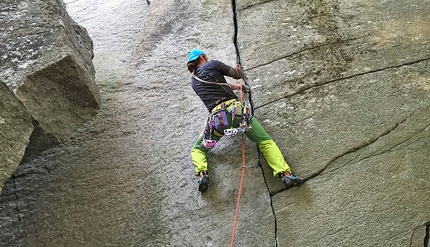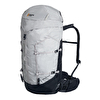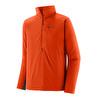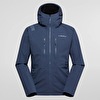Cadarese trad: 10 crack climbs in Val d'Ossola, Italy

 1 / 10
1 / 10 Maurizio Oviglia
Maurizio Oviglia
Even though some have ironically defined "trad climbing" a (false) trend that’s already losing its appeal, I believe the opposite is true and that this style of climbing is rapidly gaining popularity. There are more and more beginners, and also hardened climbers, intrigued to find out more about this particular style of climbing that is so different from sports climbing and also alpine climbing in the traditional sense, where difficult routes rarely come without any in-situ gear whatsoever. Both these categories of climbers, which we could define as beginners (even if they’re very good sports climbers), need to be taught how to place trad gear correctly by expert professionals (such as Mountain Guides) or volunteers (such as Mountain Club instructors). Furthermore, it’s also crucial that they learn how to trad climb on single pitches ideally suited to this task, where they can "learn the ropes" in a relatively controlled environment. In Italy, and in general on the European continent, there are not many clean climbing crags (i.e. those where you climb with nuts and friends only) and the routes suitable for beginners can often be counted on the fingers of one hand.
On this note, it’s worth distinguishing further between trad crack climbs (which generally speaking accept plenty of gear and can consequently be protected fairly safely) and more English-style trad routes, where obligatory crux sections above often dodgy or run-out gear require remarkable mental commitment. If crack climbing needs good instructors who can teach finger and hand jamming techniques rarely used in sports climbing, on the latter type of trad routes you need not only excellent technique, but also excellent fitness and nerves of steel. In this sense, those wishing to climb routes of this sort - often generically referred to as "hard grit" - also need to be superb sport climbers. In short, being a courageous alpinist no longer suffices, and in order to succeed you need to be a courageous sport climber! This is trad climbing, yes, but approached with a different, almost "sports climbing" mentality.
This growing demand has pushed guides and the Italian Mountaineering Club to provide updates, to ensure that all guides and instructors know about the new security techniques (in particular friends) and how to place them correctly. Given that, as mentioned previously, there are few crags suitable for these training courses (and successive courses for beginners), the vast majority of these training courses have taken place in Italy’s famous crack climbing haven, Cadarese in Val d'Ossola. While it is true that over the years the Orco Valley has earned a reputation for being the temple of Italian trad climbing (unrightly so, as many of the routes are more bolt protected sport climbs than trad),Cadarese has the most cracks concentrated in the smallest area. This is why Cadarese is normally the main choice for beginner’s rock climbing courses and refresher courses, not only for Italian climbers, but also for those from Switzerland, France, the Czech Republic, Poland and Austria.
It isn’t easy to choose which routes to climb at Cadarese as you browse through the guidebook (Versante Sud, Ossola Rock, F. Manoni, M. Pellizzon and P. Stoppini). On average those graded 6a tend to be a fairly demanding, and it you add to this the fact that in the Ossola area grades have traditionally been very strict, then it’s clear that things are more complicated then they seem.
It is for this reason that with Planetmountain.com I’m going to explore two areas ideally suited for teaching trad climbing, Cadarese and Balmanolesca. A word of warning though, as mentioned these are not easy routes, to tell the truth they're all pretty demanding, but based on my experience as instructor for Italian Mountaineering Club refresher courses, I guarantee that you can’t get much better. If you feel you’re not up to them (leading, placing all the gear), you can climb them with pre-placed gear (pink point) which is mentally a much easier undertaking. Even though this approach may seem like a sacrilege to true trad climbers, for sport climbers and those new to trad climbing, trusting the holding power of a Friend is already a big step. Another technique used by the Italian Mountaineering Club is for the leader to place the gear, clipped to a loose toprope for additional protection. Should the leader fall, and should the gear not hold, then the toprope will stop the fall. In this context, I hope these two articles are deemed useful for identifying routes that are suitable for beginners. At the same time though, I would like to underline the fact that it is better to avoid learning on your own and, instead, rely on an experienced instructor.
Beginning with Cadarese, I’m now going to introduce the sector Crack Party which in my opinion is the most suitable for the stated aim of this article. If at Balma it’s possible to climb routes greenpoint (trad climbing on sports routes, without using the bolts) at this sector in Cadarese the climbs are clean (need to be protected) but they have a bolt at the belay. A final note about the gear: most climbs require at least two sets of friends, with just one you won’t get particularly far!Last but not least, a big thank you to all those who worked to make Cadarese what it is today, in the Italian and international climbing scene. If foreign trad climbers come here, to this crag hidden in the folds of the Piedmont foothills, then there must be a reason!
by Maurizio Oviglia (CAAI, CAI INAL, IA)
CADARESE (sector Crack Party)
The routes described below are the ones I believe are ideally suited to teach crack climbing. There are of course many more climbs at this sector and the complete list is included in the guidebook.
Access: follow the access as described in the guidebook (Ossola Rock, Versante Sud 2014) by entering into Valle Antigorio to reach Terme di Premia. Park the car and walk to the second sector with some bolted cracks. Follow the ledge rightwards, this quickly becomes narrow, continue along the steps carved in the rock to reach the first routes at Sector Crack Party (20 minutes from the car park). Warning! This sector is not suited to children, the routes start from an exposed ledge!
1 – LO SCERIFFO DI CADDA (6b) – 25m
Up to the first belay, this beautiful route works as a great introduction to placing friends. The crux traverse (protected by a #0,3BD) is followed by a final layback. Two sets of friends, small and medium.
2 – MISSION GIN LEMON (6b+) – 25m
Stunning crack, finger at the start that transforms, after the tree, into a fist crack. Excellent safe pro, with Friends up to #4BD
3 – NON PARLO INGLESE (6b) – 15m
If climbed to the first belay, this diagonal crack offers an apparently easy hand crack. The climbing though is harder than it looks, with the crux at the start. Excellent protection, with mid size Friends and a #4BD at the exit.
4 – SENZA NOME (6a) – 13m
Direct start to the preceding route, ideal as a first route to the area. Friends up to #4BD
5 – SCARPEDATENNIS (6a) – 20m
Pleasant corner crack with obligatory crux finish. Bridge up the narrow chimney to the slanting corner, easy to protect, a finish left on the slab via a difficult move.
6 – UN POMERIGGIO DA LEONI (6c) – 20m
Beautiful route that fist climbs the corner crack, the via a difficult move left leads to the arete and then the finger crack finish. Demanding.
7 – LARGA MA FACILE (6a+) – 15m
Don't be put off by the name, large but easy: this route is demanding and requires extra-large Friends, such as #5 and #6BD. The first difficult move in the overhang leads to a large, good flake. A kevlar thread may be found useful to sling over the top of the flake.
8 – CIAO (5c) – 10m
At the righthand end of the sector, a short but pleasant handjam crack.
On the upper sector, above Ciao
9 – LARCO (6b) – 25m
Beautiful arch, crux at the start, finish on the next route. Mix and large Friends.
10 – LA FRECCIA (6b+) – 20m
Beautiful, technical finger crack. At 6b+, this climb seems decidedly less severe than the other routes mentioned in this article.



 Copia link
Copia link









 See all photos
See all photos























